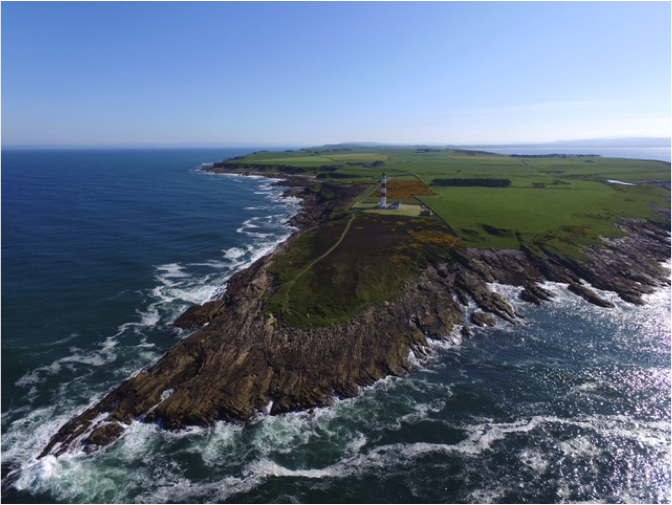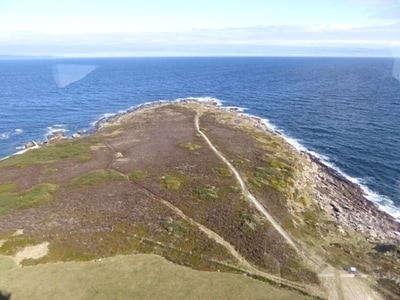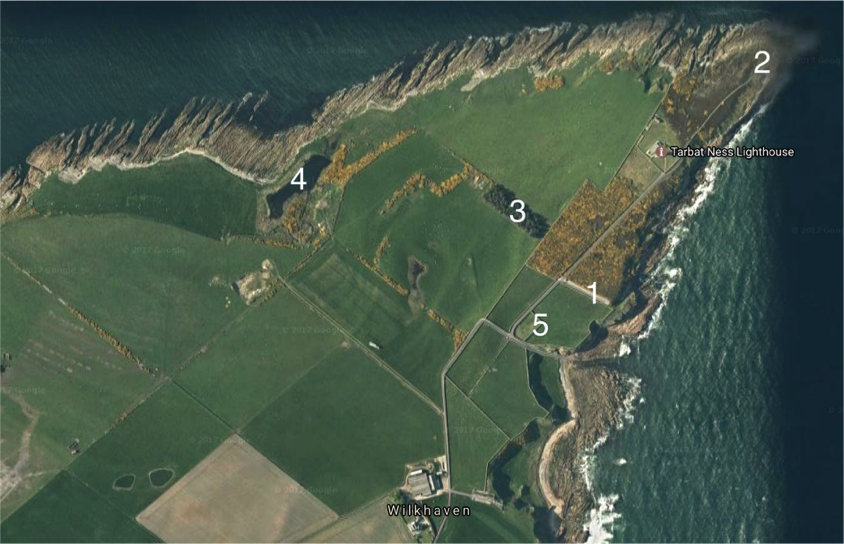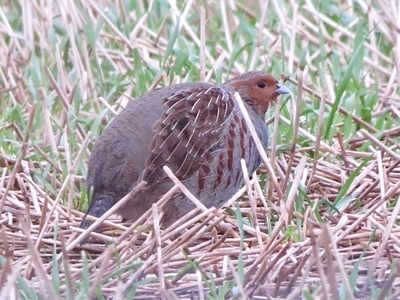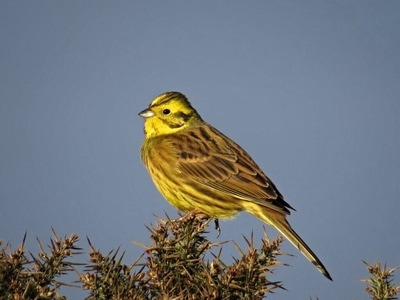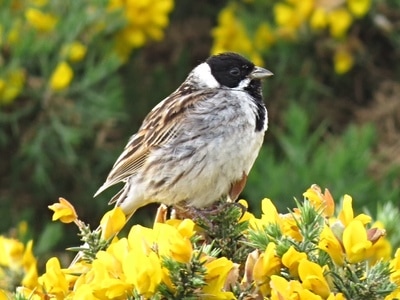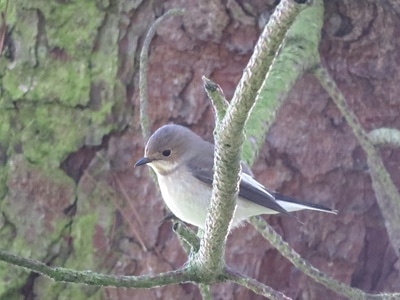Tarbat Ness by Dave Tanner
Tarbat Ness peninsula lies to the north east of Tain and projects 10 miles north-east into the outer Moray Firth (Plate 1) it is the premier sea-watching site in Easter Ross. The whole peninsula is given over to mixed farming, predominantly beef cattle and sheep grazing, some of which is on unimproved land where there is a healthy population of Rabbits and Red Foxes.
General
Tarbat Ness is owned by the local authority and has unrestricted access, except the lighthouse grounds which are private property. The area is part of the Dornoch Firth & Loch Fleet Special Protection Area (SPA), and north of the lighthouse is an SSSI. There is a general right of responsible access to all the surrounding farmland. However, if any of the fields have cattle with calves, it is strongly recommended that you do not enter, cows are extremely protective of their calves and have been known to attack if they feel threatened. Similarly, this farm has several bulls and posts signs when they are in with the heifers or cows. Otherwise, cattle in the field are docile though inquisitive and should not bother you.
Tarbat Ness is owned by the local authority and has unrestricted access, except the lighthouse grounds which are private property. The area is part of the Dornoch Firth & Loch Fleet Special Protection Area (SPA), and north of the lighthouse is an SSSI. There is a general right of responsible access to all the surrounding farmland. However, if any of the fields have cattle with calves, it is strongly recommended that you do not enter, cows are extremely protective of their calves and have been known to attack if they feel threatened. Similarly, this farm has several bulls and posts signs when they are in with the heifers or cows. Otherwise, cattle in the field are docile though inquisitive and should not bother you.
1 - There is ample car-parking - OS ref: NH9452387288. Map Code (TomTom) Ref: K71Y.7J8
The four main sites of interest are:
2 - The Point - OS Ref: NH9490087722 - Sea-Watching.
3 - The Plantation - OS Ref: NH9439187464 - Migration Trap.
4 - The Pool - OS Ref: NH9397987533 - Migration Trap.
5 - Walled Garden - OS Ref: NH9441887218 - Migration Trap.
The four main sites of interest are:
2 - The Point - OS Ref: NH9490087722 - Sea-Watching.
3 - The Plantation - OS Ref: NH9439187464 - Migration Trap.
4 - The Pool - OS Ref: NH9397987533 - Migration Trap.
5 - Walled Garden - OS Ref: NH9441887218 - Migration Trap.
The primary attraction of Tarbat Ness is seawatching all year and particularly autumn migration, to a lesser degree spring migration can be interesting.
The fields surrounding Tarbat Ness can hold spectacular numbers of swans and geese during early and late winter and early spring, predominantly Whooper Swan, Pink-feet and Greylags, but Greenland White-fronts are annual. Flocks have held - Snow Goose, European White-fronted Goose, Tundra Bean Goose and Barnacle Goose, Canada and Brent Geese are rare off the point. A pair of Shelduck usual breed near the point. Good numbers of seaduck can be seen off and passing the point during autumn, winter and spring. Eider in good numbers, Common Scoter sometimes contain Velvet Scoter and Long-tailed Duck are regular during winter. Red-breasted Merganser occasionally in late winter and spring.
Grey Partridge are present in the surrounding fields but never easy to see, early morning is best.
The fields surrounding Tarbat Ness can hold spectacular numbers of swans and geese during early and late winter and early spring, predominantly Whooper Swan, Pink-feet and Greylags, but Greenland White-fronts are annual. Flocks have held - Snow Goose, European White-fronted Goose, Tundra Bean Goose and Barnacle Goose, Canada and Brent Geese are rare off the point. A pair of Shelduck usual breed near the point. Good numbers of seaduck can be seen off and passing the point during autumn, winter and spring. Eider in good numbers, Common Scoter sometimes contain Velvet Scoter and Long-tailed Duck are regular during winter. Red-breasted Merganser occasionally in late winter and spring.
Grey Partridge are present in the surrounding fields but never easy to see, early morning is best.
All 3 divers can be seen from the point, Red-throated and Great Northern (smaller numbers of GND in the summer) all year and occasionally Black-throated during winter. Slavonian Grebe occasionally in the winter too.
Fulmar (Blue morph during autumn and early winter) and Gannet all year often in spectacular numbers during late summer early autumn, particularly with an onshore wind NNE - E. Great and Cory's Shearwater have both been recorded though remain very rare. Manx Shearwater during the summer months can often be seen in spectacular numbers, Balearic Shearwater is probably annual, though under reported, late August - September and is recorded most years. One of the main attractions at Tarbat Ness is the annual passage of Sooty Shearwater which can start as early as June and continue through to October/November, again an onshore wind improves prospects. Storm Petrel and occasionally Leach's can be seen during late summer, strong onshore wind NNE - NE.
Hen Harrier occasionally during winter, Buzzard and Peregrine are local breeders. Osprey and Red Kite have been recorded. Sparrowhawk, Kestrel and Merlin are regularly seen and there is a single autumn record of Red-footed Falcon. Passage Hobby has been recorded on a few occasions.
At least one record of Common Crane during winter.
Tarbat Ness is not noted for its wader passage, there just isn't the habitat to hold them with the exception of Purple Sandpiper and Turnstone during winter, best looked for around the rocky point. Knot, Dunlin, Little Stint, Wood and Common Sandpiper have been recorded. Whimbrel and Greenshank are annual during spring and autumn migration. Black and Bar-tailed Godwit have been recorded though remain uncommon.
Woodcock are present during the winter and can usually be found around the car-park or alongside the approach path early morning. There is usually a Jack Snipe present around the perimeter of the pool, the north end is usually best near the outfall.
All 4 skuas can be seen off the point, Great and Arctic Skua early spring to late summer, both have wintered in the Dornoch Firth, Pomarine Skua late spring and late autumn occasionally well into winter. Long-tailed Skua occasionally spring and autumn though not recorded annually.
All the regular gulls can be seen off the point though Lesser Black-backed Gull is never common. Little Gull can turn up any time of the year, Kittiwake all year and sometimes in spectacular numbers, autumn/winter. Sabines Gull is another under reported species and is probably annual during late autumn. Glaucous and Iceland are annual though late winter is best. Ivory Gull (Rare) has been recorded during midwinter. Little Tern are annual late summer, Sandwich Tern spring through to autumn and Arctic Tern during spring and autumn passage. Common Tern are never common. Black Tern is regularly recorded in autumn, another species that is probably under recorded.
Little Auk regularly during winter in NNE - E storm conditions, sometimes in spectacular numbers in the thousands. Puffin though uncommon are regularly off the point during the summer. Black Guillemot are present all year and can be seen in good numbers 50+ off the point in late summer in calm conditions when they regularly 'loaf about' off the point. Guillemot and Razorbill are present all year and in huge numbers during the summer.
Short-eared Owl are an autumn passage bird occasionally hanging around for a few days. Barn Owl is probably resident but rare and may breed.
Swift are present during summer but never common, can usually be seen feeding around the lighthouse beacon. Skylark are a common breeder and are sometimes present in huge numbers during harsh winters. Small numbers of Sand Martin breed around the Tarbat Peninsula, there's a healthy local population of Swallow and House Martin breed below the lighthouse beacon. Rock Pipit and Meadow Pipit are local breeders, Richards Pipit (Rare) has been recorded. Pied Wagtail is a local breeder, Grey Wagtail may breed and small family groups are seen occasionally post breeding at the point. White Wagtail are annual passage migrant, mainly spring with smaller number in early autumn. There is a single autumn record of Red-flanked Bluetail (Rare), Common Redstart is annual in the autumn, both at the plantation. Black Redstart has also been recorded at the point in late summer. Northern Wheatear is another passage spring and autumn migrant and may breed locally. Stonechat breed in small numbers at various locations around the point, and Whinchat is an autumn passage bird.
During autumn the fields around the plantation can hold spectacular numbers of Redwing, Mistle Thrush and Fieldfare. Ring Ouzel occasionally turn up in the autumn.
Fulmar (Blue morph during autumn and early winter) and Gannet all year often in spectacular numbers during late summer early autumn, particularly with an onshore wind NNE - E. Great and Cory's Shearwater have both been recorded though remain very rare. Manx Shearwater during the summer months can often be seen in spectacular numbers, Balearic Shearwater is probably annual, though under reported, late August - September and is recorded most years. One of the main attractions at Tarbat Ness is the annual passage of Sooty Shearwater which can start as early as June and continue through to October/November, again an onshore wind improves prospects. Storm Petrel and occasionally Leach's can be seen during late summer, strong onshore wind NNE - NE.
Hen Harrier occasionally during winter, Buzzard and Peregrine are local breeders. Osprey and Red Kite have been recorded. Sparrowhawk, Kestrel and Merlin are regularly seen and there is a single autumn record of Red-footed Falcon. Passage Hobby has been recorded on a few occasions.
At least one record of Common Crane during winter.
Tarbat Ness is not noted for its wader passage, there just isn't the habitat to hold them with the exception of Purple Sandpiper and Turnstone during winter, best looked for around the rocky point. Knot, Dunlin, Little Stint, Wood and Common Sandpiper have been recorded. Whimbrel and Greenshank are annual during spring and autumn migration. Black and Bar-tailed Godwit have been recorded though remain uncommon.
Woodcock are present during the winter and can usually be found around the car-park or alongside the approach path early morning. There is usually a Jack Snipe present around the perimeter of the pool, the north end is usually best near the outfall.
All 4 skuas can be seen off the point, Great and Arctic Skua early spring to late summer, both have wintered in the Dornoch Firth, Pomarine Skua late spring and late autumn occasionally well into winter. Long-tailed Skua occasionally spring and autumn though not recorded annually.
All the regular gulls can be seen off the point though Lesser Black-backed Gull is never common. Little Gull can turn up any time of the year, Kittiwake all year and sometimes in spectacular numbers, autumn/winter. Sabines Gull is another under reported species and is probably annual during late autumn. Glaucous and Iceland are annual though late winter is best. Ivory Gull (Rare) has been recorded during midwinter. Little Tern are annual late summer, Sandwich Tern spring through to autumn and Arctic Tern during spring and autumn passage. Common Tern are never common. Black Tern is regularly recorded in autumn, another species that is probably under recorded.
Little Auk regularly during winter in NNE - E storm conditions, sometimes in spectacular numbers in the thousands. Puffin though uncommon are regularly off the point during the summer. Black Guillemot are present all year and can be seen in good numbers 50+ off the point in late summer in calm conditions when they regularly 'loaf about' off the point. Guillemot and Razorbill are present all year and in huge numbers during the summer.
Short-eared Owl are an autumn passage bird occasionally hanging around for a few days. Barn Owl is probably resident but rare and may breed.
Swift are present during summer but never common, can usually be seen feeding around the lighthouse beacon. Skylark are a common breeder and are sometimes present in huge numbers during harsh winters. Small numbers of Sand Martin breed around the Tarbat Peninsula, there's a healthy local population of Swallow and House Martin breed below the lighthouse beacon. Rock Pipit and Meadow Pipit are local breeders, Richards Pipit (Rare) has been recorded. Pied Wagtail is a local breeder, Grey Wagtail may breed and small family groups are seen occasionally post breeding at the point. White Wagtail are annual passage migrant, mainly spring with smaller number in early autumn. There is a single autumn record of Red-flanked Bluetail (Rare), Common Redstart is annual in the autumn, both at the plantation. Black Redstart has also been recorded at the point in late summer. Northern Wheatear is another passage spring and autumn migrant and may breed locally. Stonechat breed in small numbers at various locations around the point, and Whinchat is an autumn passage bird.
During autumn the fields around the plantation can hold spectacular numbers of Redwing, Mistle Thrush and Fieldfare. Ring Ouzel occasionally turn up in the autumn.
Of the warblers Willow Warbler, Common Whitethroat and Sedge Warbler breed, all others are passage/vargrant birds. Barred Warbler, Garden Warbler, Lesser Whitethroat, Reed Warbler, Icterine Warbler (Rare), Booted/Sykes Warbler (Rare), Subalpine Warbler (Rare), Common Chiffchaff (annual), Siberian Chiffchaff (Probably annual), Greenish Warbler (Rare), Yellow-browed Warbler (annual), Pallas's Warbler (Rare), Passage and vagrant warblers can turn up anywhere at Tarbat Ness. The gorse either side of the approach path is now much more accessible having been opened up by fire to the right and habitat work by Scottish Hydro to the left. The plantation and the area of Willows and Willow Herb around the pool are excellent migrant traps during autumn.
Spotted (annual) Red-breasted (rare) and Pied Flycatcher (annual) are best looked for in the plantation during autumn.
Most of the common passerines are present near the car-park feeders and during the winter Brambling, Lesser Redpoll and Long-tailed Tit are occasionally present. Yellowhammer are present all year, they are a local breeder in very good numbers. Continental Coal Tit have been recorded on the feeders during winter.
There is a single autumn record of Great Grey Shrike and Red-backed Shrike have been recorded on several occasions, early summer and autumn.
Tarbat Ness is probably the best location to see a locally rare breeder Magpie a pair have been present now for several years. Hooded and Hybrid Crows are both present and Raven have also bred locally for several years.
Tree Sparrow are local residents, best looked for around the car-park feeders or Wilkhaven Farm house. Reed Bunting breed.
During harsh winters Snow Bunting can be found in the fields south of Wilkhaven Farm House in spectacular numbers, 5000 reported in the late 90’s and 500+ in harsh winter 2009/10. Lapland Bunting have been recorded but remain rare.
Other rare vagrants recorded at Tarbat Ness - Wryneck, Little Bunting, Mealy Redpoll, Sabine's Gull.
In total more than 180 species of bird have been recorded and accepted at Tarbat Ness.
Cetaceans & Mammals.
Bottlenose Dolphin - all year.
Minke Whale - June - October.
Orca & Humpback have been seen but are rare.
Atlantic Grey Seal - Daily.
Common Seal - Occasional
Otter - Regular but better from early autumn to late winter.
Stoat - Regular at the point all year.
Roe Deer - Daily
Brown Hare - Regular.
Rabbit - Common.
Red Fox - Common.
Local Facilities.
There are public toilets in Portmahomack, open daily all year.
There is a café in the village hall: Carnegie Café, Well Street (Opposite the telephone kiosk)
(Open - Mon - Tue - Fri & Sat - 10am - 4pm)
Village Shop and Post Office, Main Street - is open daily selling wide range of food & drinks including takeaway hot drinks.
Spotted (annual) Red-breasted (rare) and Pied Flycatcher (annual) are best looked for in the plantation during autumn.
Most of the common passerines are present near the car-park feeders and during the winter Brambling, Lesser Redpoll and Long-tailed Tit are occasionally present. Yellowhammer are present all year, they are a local breeder in very good numbers. Continental Coal Tit have been recorded on the feeders during winter.
There is a single autumn record of Great Grey Shrike and Red-backed Shrike have been recorded on several occasions, early summer and autumn.
Tarbat Ness is probably the best location to see a locally rare breeder Magpie a pair have been present now for several years. Hooded and Hybrid Crows are both present and Raven have also bred locally for several years.
Tree Sparrow are local residents, best looked for around the car-park feeders or Wilkhaven Farm house. Reed Bunting breed.
During harsh winters Snow Bunting can be found in the fields south of Wilkhaven Farm House in spectacular numbers, 5000 reported in the late 90’s and 500+ in harsh winter 2009/10. Lapland Bunting have been recorded but remain rare.
Other rare vagrants recorded at Tarbat Ness - Wryneck, Little Bunting, Mealy Redpoll, Sabine's Gull.
In total more than 180 species of bird have been recorded and accepted at Tarbat Ness.
Cetaceans & Mammals.
Bottlenose Dolphin - all year.
Minke Whale - June - October.
Orca & Humpback have been seen but are rare.
Atlantic Grey Seal - Daily.
Common Seal - Occasional
Otter - Regular but better from early autumn to late winter.
Stoat - Regular at the point all year.
Roe Deer - Daily
Brown Hare - Regular.
Rabbit - Common.
Red Fox - Common.
Local Facilities.
There are public toilets in Portmahomack, open daily all year.
There is a café in the village hall: Carnegie Café, Well Street (Opposite the telephone kiosk)
(Open - Mon - Tue - Fri & Sat - 10am - 4pm)
Village Shop and Post Office, Main Street - is open daily selling wide range of food & drinks including takeaway hot drinks.
